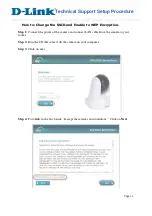
1. In the left-menu pane, select
Network > SNMP
.
2. On the SNMP page, select the
Enable SNMP
check box.
3. From the
Version
drop-down list, select the preferred SNMP version. Be aware that both versions can
be configured, but only one can be enabled at a time:
l
SNMP v2c
: Using SNMP v2c, you can make a request to the camera for status information
through an SNMP Get request and receive trap notifications from the camera.
In the
SNMP v2c Settings
area, select the
Enable Traps
check box to enable traps from the
camera.
a.
Read Community:
enter the read community name for the camera. The name is used to
authenticate SNMP traffic. Only SNMP management stations with the same read
community name will receive a response from the camera.
b.
Trap Destination IP:
enter the IP address of the management station where the traps
will be sent.
In the Available Traps area, select the traps that will be sent:
l
Temperature Alert:
a trap notification will be sent when the camera temperature
rises above or falls below the supported threshold. A notification will also be
sent when the camera temperature returns to normal.
l
Camera Tampering:
a trap notification will be sent when the camera's video
analytics detects a sudden scene change.
l
Edge Storage Status:
a trap notification will be sent when the status of the SD
card changes.
l
SNMP v3:
Using SNMP v3, you can request status information through an SNMP Get request.
SNMP v3 does not support traps.
SNMP v3 offers greater security by allowing you to set a username and password for the
camera. This camera uses SHA-1 type authentication and AES type encryption.
In the SNMP v3 Settings area, complete the following:
a.
Username:
enter the username that the management station must use when sending
the SNMP Get request to the camera.
b.
Password:
enter the password the management station must use with the chosen
username.
4. Click
Apply
to save your changes.
Advanced Network
For greater network communication security, you can enable compliance with the Federal Information
Processing Standard (FIPS) 140-2 Level 1 or Level 3 Security Requirements for Cryptographic Modules for
server and camera communication.
Advanced Network
15
















































